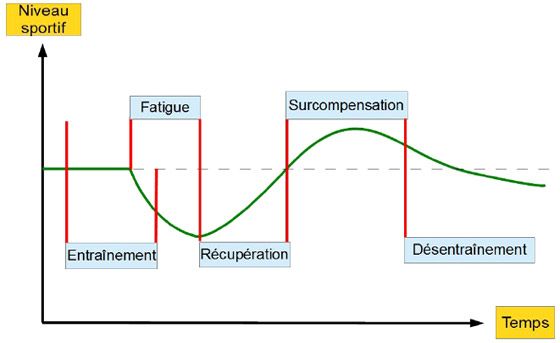How to optimize your recovery?

To gain muscle, you have to work out. Until then, I haven't told you anything. It is accepted that the more you train, the more you progress. This is true, but only to a certain extent. Indeed, training is the stimulus (stimulation) which tells your body that it must adapt to cope with stress. But for this to happen, you must give your body the means to do so.
It is said that: “It is by recovering that we progress. » This is true, but simply leaving time between two sessions is not enough. Your recovery capacity is limited and progresses very little compared to your training capacity. So this may cause you problems as your level increases.
So how can we recover sufficiently so that we can continue to progress without becoming exhausted? To answer this question, let's first see how recovery takes place.
Overcompensation
After a workout, your level is temporarily lower than before you started it. This is due to fatigue caused by your session. With sufficient rest, you will gradually return to your initial level and then exceed it. It is this last step which is called “overcompensation”.

The main aspects of recovery
Recovery isn't just about doing nothing or sleeping. It has many facets that are best taken into account to recover effectively. Here is a summary list:
THE ENERGY PLAN
Your body uses many substances during exercise: glycogen, fatty acids, creatine , amino acids, water, vitamins, minerals. To repair and build muscle, you must therefore replenish these reserves, or even provide a surplus for certain ones (e.g. amino acids, carbohydrates ) in order to reduce catabolism (destruction) and promote muscle anabolism (construction).
THE MUSCLE PLAN
During a weight training session, muscle fibers are damaged. We recommend a period of 48 hours between two requests to the same muscle so that it regenerates. In the case of intense eccentric work, muscle repair may take more than 4 days.
It is important to note that tendons are much less vascularized than muscles. Thus, in the event of damage, it takes much longer to heal (e.g. tendinitis).
THE JOINT PLAN
As with tendons, bones and cartilage take a very long time to regenerate. Frequent overuse coupled with insufficient rest can cause osteoarthritis. Heavy work (more than 80% of 1RM ) for example, is particularly taxing on the joints.
THE NERVOUS PLAN
Muscle contraction comes from the nervous system. Its contribution is therefore very important in bodybuilding. If you are nervously flat, you will not be able to contract your muscles effectively. Here again, heavy work will strongly tax your nervous system and will therefore require more recovery than medium or light loads. Complete recovery of the nervous system may take more than a week.
THE HORMONAL PLAN
Strength training causes the secretion or decrease of many hormones (cortisol, growth hormone, testosterone). This is necessary for adaptation to the stress of training, but disrupts the homeostasis (balance) of your body which will then have to return to a stable state. This can take from a few hours to several days.

THE IMMUNE PLAN:
After your session, your immune system is weakened. This leaves the door open for bacteria and viruses. While your immunity is restored, you will need to cover yourself well to avoid catching a cold.
Active or passive recovery?
PASSIVE RECOVERY
This corresponds to what you can implement to speed up or improve your recovery indirectly from your actions. Here are some examples in order of priority:
- sleep (at night or take a nap)
- eat (a suitable diet is essential to gain muscle)
- take a complete day of rest (no training)
- get a massage or do electro-stimulation
- wear compression garments
- make a sauna, jacuzzi, hammam
- do cryotherapy
ACTIVE RECOVERY
Unlike passive recovery, in this case, it is your actions that will directly accelerate or improve your recovery . Here are some ways:
- the cleaning
- stretching (without the objective of gaining flexibility)
- self-massages
Conclusion
As you can see, there are many different ways of recovery. It's up to you to test and choose what you like best, but above all what works best for you.
In any case, know that you can very well mix active and passive recovery, but also vary the means. This is also how you will obtain the best results because the body adapts to stress but also to what relieves it.
.png)